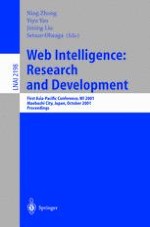2001 | Buch
Web Intelligence: Research and Development
First Asia-Pacific Conference, WI 2001 Maebashi City, Japan, October 23–26, 2001 Proceedings
herausgegeben von: Ning Zhong, Yiju Yao, Jiming Liu, Setsuo Ohsuga
Verlag: Springer Berlin Heidelberg
Buchreihe : Lecture Notes in Computer Science
Enthalten in: Professional Book Archive
